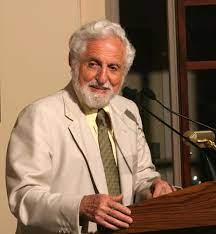The contraception case study
A group of medical students are attending a lecture on pharmacology when suddenly all the doors of the hall are closed. On the multimedia, a case study is presented. The object of an academic study is a young married woman who suffers from sickle cell anemia. She and her husband would like to have a child but after an examination, it turns out that a potential pregnancy could be dangerous and even deadly for her. Now the couple is trying to prevent a potential pregnancy. The students are given one hour to solve a group of puzzles in the field of biology, chemistry and medicine to find ways to help the young couple to achieve their goal. The narrator is Carl Djerassi- an inventor of one type of contraception pill.
Carl Djerassi
Carl Djerassi (October 29, 1923 – January 30, 2015) was an Austrian-born Bulgarian-American chemist, novelist, playwright and co-founder of Djerassi Resident Artists Program with Diane Wood Middlebrook. He is best known for his contribution to the development of oral contraceptive pills, nicknamed the father of the pill.
Carl Djerassi was born in Vienna, Austria, but spent the first years of his infancy in Sofia, Bulgaria, the home of his father, Samuel Djerassi, a dermatologist and specialist in sexually transmitted diseases. Djerassi started his college career at Newark Junior College, briefly attended Tarkio College, and then studied chemistry at Kenyon College, where he graduated summa cum laude. After one year at CIBA, he moved to the University of Wisconsin–Madison where he earned his Ph.D. in organic chemistry in 1945. His thesis work examined the transformation of the male sex hormone testosterone into the female sex hormone estradiol, through a sequence of chemical reactions. Djerassi participated in the invention in 1951, together with Mexican Luis E. Miramontes and Hungarian-Mexican George Rosenkranz, of the progestin norethisterone—which, unlike progesterone, remained effective when taken orally and was far stronger than the naturally occurring hormone. His preparation was first administered as an oral contraceptive to animals by Gregory Goodwin Pincus and Min Chueh Chang and to women by John Rock.

